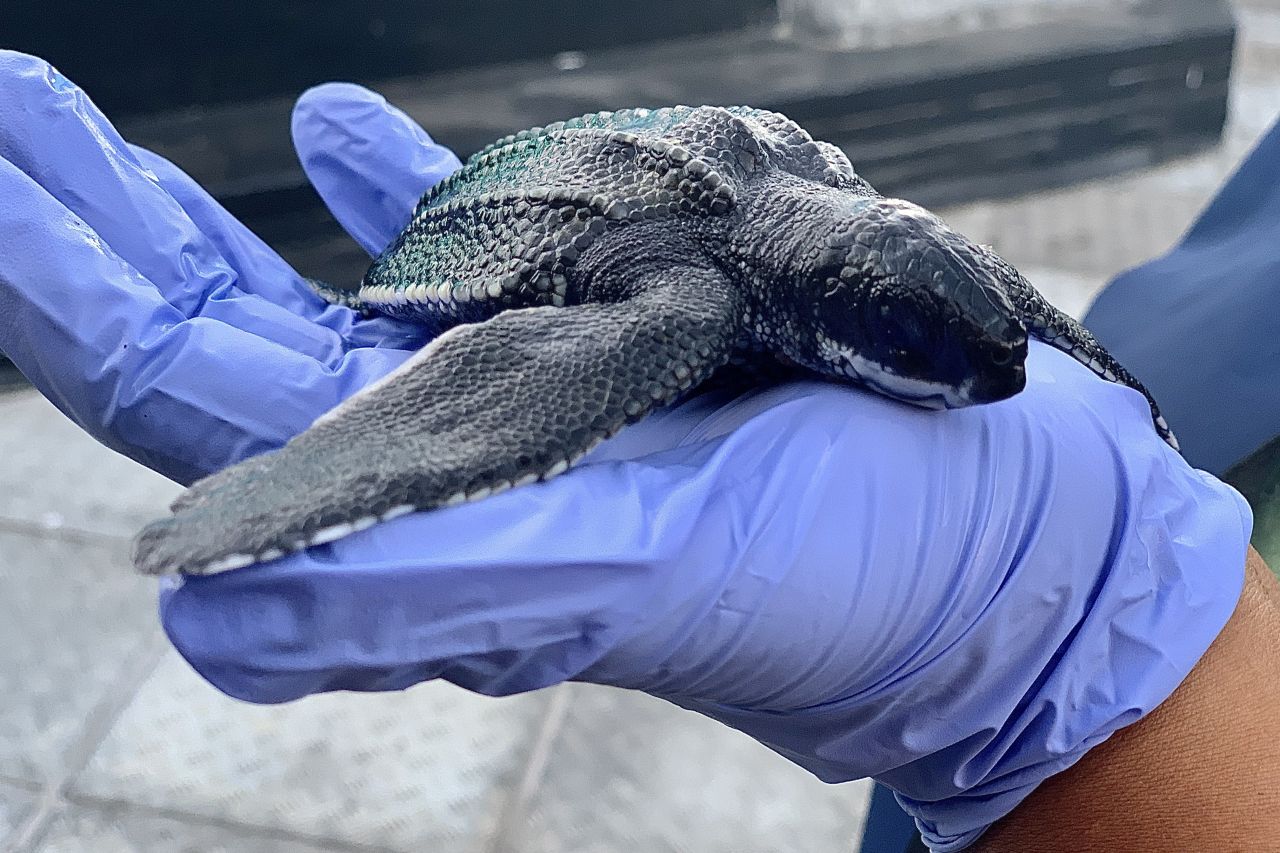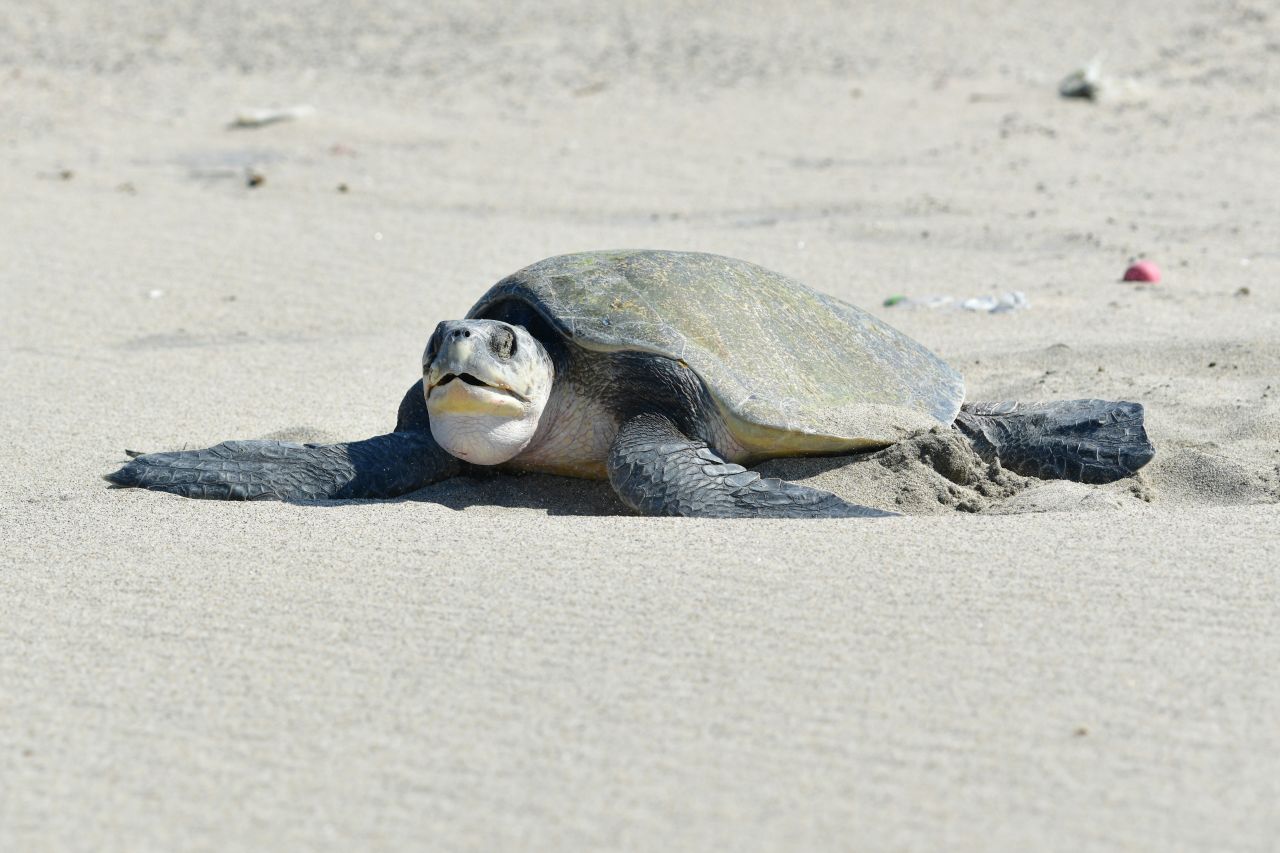How to tell the difference between turtle species
South Africa's ocean is home to five species of sea turtle - some of which are temporarily housed at the Two Oceans Aquarium in our I&J Ocean Exhibit while undergoing rehabilitation with our Foundation’s Turtle Conservation Centre. Here, the turtles have time to get stronger and be observed by our Turtle Team before they are released into the ocean.
Aquarium visitors may notice that the turtles in the I&J Ocean Exhibit are rather diverse in appearance. But have you ever wondered how to tell them apart?
Turtles cannot be distinguished by looking at their colour alone, as this is highly variable in most species. Instead, we look at the shape of the head, bill, body, and carapace (shell). One of the primary methods of differentiating turtle species is looking at the number of scutes (shell plates) on their carapace.
Here's our guide to differentiating the five turtle species in South Africa:
Loggerhead turtle:
The loggerhead turtle nests in KwaZulu Natal. As an indigenous species, it is the most common turtle in southern Africa, and our Foundation’s Turtle Conservation Centre regularly rehabilitates stranded loggerhead turtle hatchlings and adults.
The loggerhead turtle's most defining characteristic is its large head, with powerful jaws to crush prey like horseshoe crabs, urchins, molluscs, and starfish. The largest hard-shelled turtle species, loggerhead turtles grow to roughly 450kg and live for around 80 years. Unfortunately, their populations are listed as vulnerable and declining on the IUCN’s Red List of Threatened Species.
In terms of appearance, the loggerhead turtle is quite distinctive. Its head is disproportionately large, and its bill is hooked. Loggerhead turtles have five central and five lateral scutes – you can count them on the image here.
Currently, in the I&J Ocean Exhibit, loggerhead turtle Nobomvu is enjoying stretching her flippers.
Leatherback turtle:
The leatherback turtle is the most prehistoric-looking turtle species, and for good reason: It is the only remaining member of the turtle family that can trace its evolutionary roots back more than 100 million years!
Leatherbacks feed solely on jellyfish and nest in KwaZulu Natal. Like all other turtle species, its population is vulnerable and declining in number.
The leatherback turtle, the largest sea turtle in the world, is the only species without a hard carapace. Instead, it has a flexible, leathery carapace, hence its name. This thick, rubbery skin is an excellent insulator, allowing it to dive up to 1.5km deep in cold waters. The leatherback turtle can grow to 750kg and live for over 100 years.
The leatherback turtle’s inky blue-black colour and impressive size are distinctive. A pink spot on the crown of its head, known as the pineal spot, is unique to each turtle and often used in identification. The carapace is teardrop-shaped and composed of cartilage raised into seven longitudinal ridges.

Green turtle:
The green turtle is so named because the fat layer underneath the carapace is green! It is also the only turtle species with a solely herbivorous diet. They eat various proteins as hatchlings, like crustaceans and fish eggs, but switch to entirely herbivores in adulthood. They enjoy a variety of algae, seaweed, and seagrasses in adulthood.
Green turtles are widespread across the globe, nesting in 80 countries, and are commonly seen in South African waters. Adults can weigh up to 395kg and live for over 70 years. Unfortunately, the species are endangered and declining in numbers.
Green turtles have five central and four lateral scutes. The carapace is smooth and round. The external colour ranges from very dark to light brown, often with a much lighter plastron (bottom shell). Green turtles are the “neatest” looking turtle species, characterised by their smooth carapaces and uniform colouration.
Currently, green turtles Bheni and Nori are exploring the I&J Ocean Exhibit.
Hawksbill turtle:
The hawksbill turtle is named for its curved beak and known for its beautifully patterned carapace. One of the main reasons for the hawksbill turtle’s status as critically endangered is their being poached for their “tortoiseshell” carapace, used for jewellery and accessories.
The hawksbill turtle does not nest in South Africa but enters our water as a stray, searching for sub-tropical feeding grounds where they forage sea sponges, algae, squid, and shrimp. The hawksbill turtle’s diet is up to 95% sea sponges, some of which are toxic. The hawksbill turtle’s body fat absorbs the toxins without affecting the turtle, but their flesh is poisonous to predators and humans.
Hawksbill turtles have five central scutes and four lateral scutes. The hawksbill turtle’s shell is serrated and has overlapping scutes. While young, the carapace is heart-shaped but elongates as it matures. The most distinguishing factor is, of course, the beautiful tortoiseshell pattern.
Olive ridley turtle:
The olive ridley turtle is unique in its display of arribada, where hundreds of thousands of turtles nest together on one beach.
So named for the colour of its olive-green carapace, the olive ridley turtle enters South African waters as a stray. This turtle is the smallest in our waters: the average weight is 35kg.
Olive ridley turtles are solitary, preferring open ocean. They feed on crabs, shrimp, lobster, urchins, jellyfish, algae, and fish. Although the olive ridley turtle is the most abundant species, it is still listed as vulnerable on the IUCN’s Red List.
Olive ridleys have five central scutes and six or more lateral scutes. The carapace is almost completely round when viewed from above. Of course, their green-tinged carapaces are a sure way of identifying them.

So, next time you visit the Two Oceans Aquarium, see if you can identify the turtle species in the I&J Ocean Exhibit!
Related News
Sign up to our Newsletter
Receive monthly news, online courses and conservation programmes.




